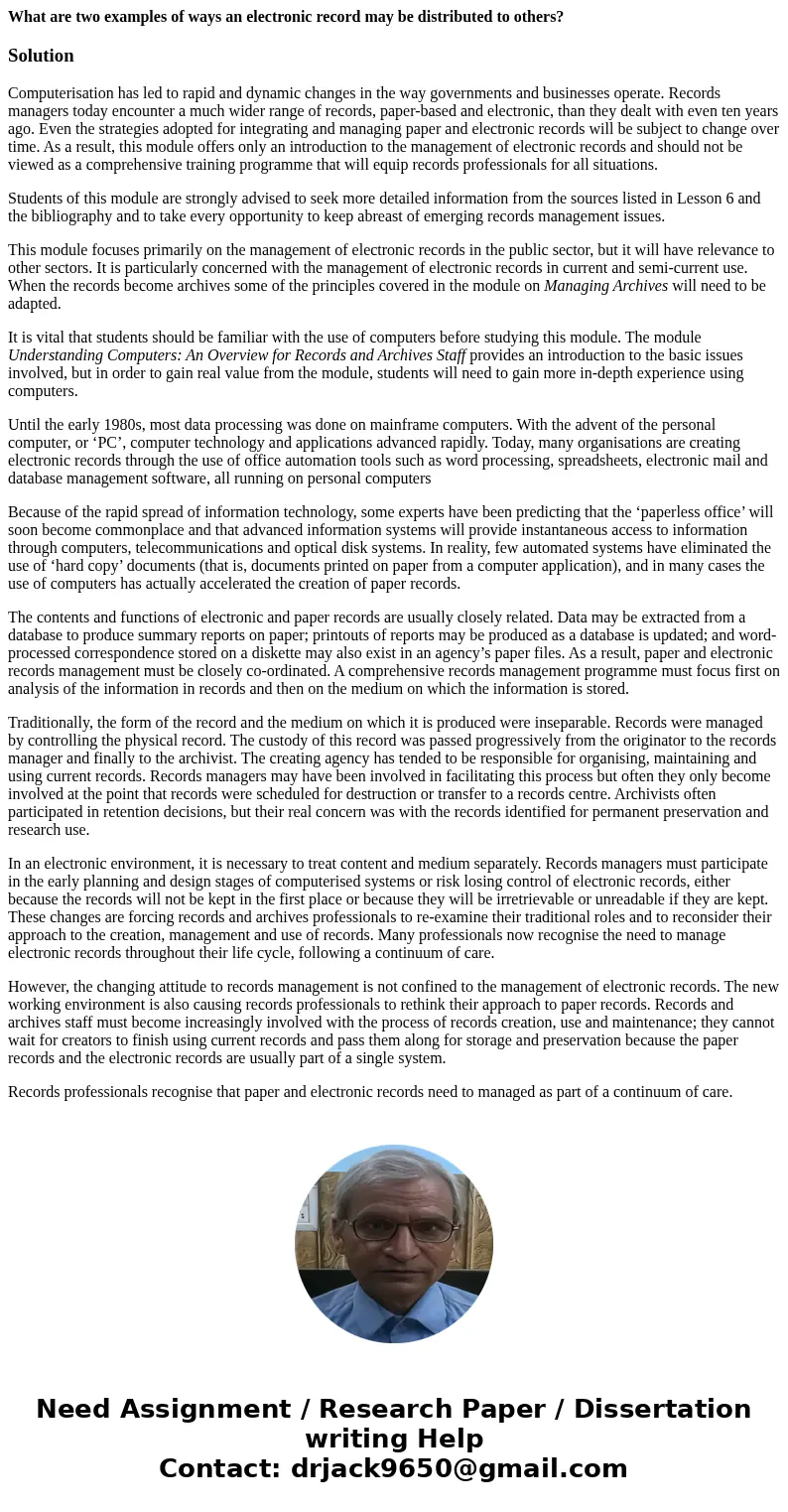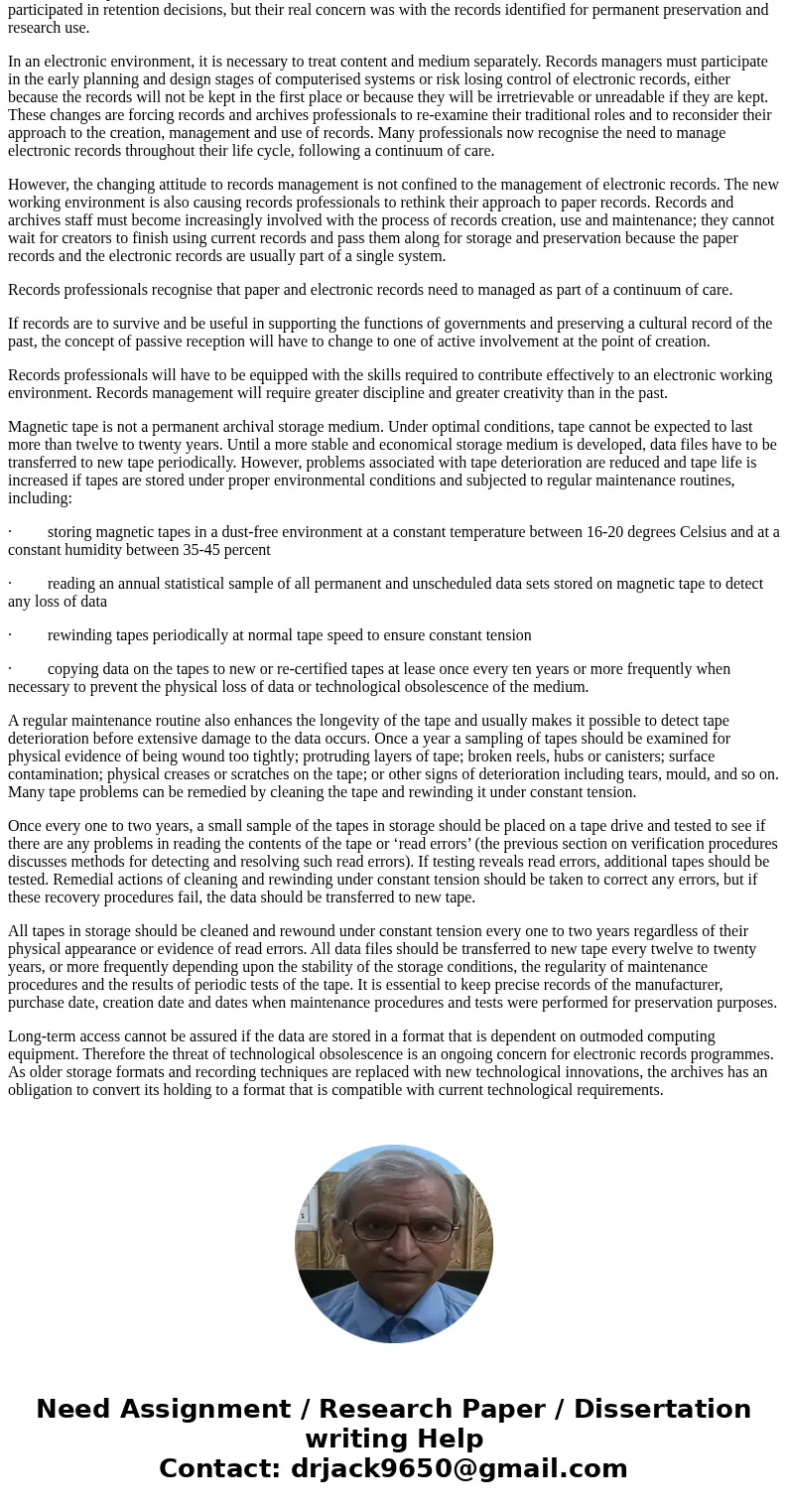What are two examples of ways an electronic record may be di
What are two examples of ways an electronic record may be distributed to others?
Solution
Computerisation has led to rapid and dynamic changes in the way governments and businesses operate. Records managers today encounter a much wider range of records, paper-based and electronic, than they dealt with even ten years ago. Even the strategies adopted for integrating and managing paper and electronic records will be subject to change over time. As a result, this module offers only an introduction to the management of electronic records and should not be viewed as a comprehensive training programme that will equip records professionals for all situations.
Students of this module are strongly advised to seek more detailed information from the sources listed in Lesson 6 and the bibliography and to take every opportunity to keep abreast of emerging records management issues.
This module focuses primarily on the management of electronic records in the public sector, but it will have relevance to other sectors. It is particularly concerned with the management of electronic records in current and semi-current use. When the records become archives some of the principles covered in the module on Managing Archives will need to be adapted.
It is vital that students should be familiar with the use of computers before studying this module. The module Understanding Computers: An Overview for Records and Archives Staff provides an introduction to the basic issues involved, but in order to gain real value from the module, students will need to gain more in-depth experience using computers.
Until the early 1980s, most data processing was done on mainframe computers. With the advent of the personal computer, or ‘PC’, computer technology and applications advanced rapidly. Today, many organisations are creating electronic records through the use of office automation tools such as word processing, spreadsheets, electronic mail and database management software, all running on personal computers
Because of the rapid spread of information technology, some experts have been predicting that the ‘paperless office’ will soon become commonplace and that advanced information systems will provide instantaneous access to information through computers, telecommunications and optical disk systems. In reality, few automated systems have eliminated the use of ‘hard copy’ documents (that is, documents printed on paper from a computer application), and in many cases the use of computers has actually accelerated the creation of paper records.
The contents and functions of electronic and paper records are usually closely related. Data may be extracted from a database to produce summary reports on paper; printouts of reports may be produced as a database is updated; and word-processed correspondence stored on a diskette may also exist in an agency’s paper files. As a result, paper and electronic records management must be closely co-ordinated. A comprehensive records management programme must focus first on analysis of the information in records and then on the medium on which the information is stored.
Traditionally, the form of the record and the medium on which it is produced were inseparable. Records were managed by controlling the physical record. The custody of this record was passed progressively from the originator to the records manager and finally to the archivist. The creating agency has tended to be responsible for organising, maintaining and using current records. Records managers may have been involved in facilitating this process but often they only become involved at the point that records were scheduled for destruction or transfer to a records centre. Archivists often participated in retention decisions, but their real concern was with the records identified for permanent preservation and research use.
In an electronic environment, it is necessary to treat content and medium separately. Records managers must participate in the early planning and design stages of computerised systems or risk losing control of electronic records, either because the records will not be kept in the first place or because they will be irretrievable or unreadable if they are kept. These changes are forcing records and archives professionals to re-examine their traditional roles and to reconsider their approach to the creation, management and use of records. Many professionals now recognise the need to manage electronic records throughout their life cycle, following a continuum of care.
However, the changing attitude to records management is not confined to the management of electronic records. The new working environment is also causing records professionals to rethink their approach to paper records. Records and archives staff must become increasingly involved with the process of records creation, use and maintenance; they cannot wait for creators to finish using current records and pass them along for storage and preservation because the paper records and the electronic records are usually part of a single system.
Records professionals recognise that paper and electronic records need to managed as part of a continuum of care.
If records are to survive and be useful in supporting the functions of governments and preserving a cultural record of the past, the concept of passive reception will have to change to one of active involvement at the point of creation.
Records professionals will have to be equipped with the skills required to contribute effectively to an electronic working environment. Records management will require greater discipline and greater creativity than in the past.
Magnetic tape is not a permanent archival storage medium. Under optimal conditions, tape cannot be expected to last more than twelve to twenty years. Until a more stable and economical storage medium is developed, data files have to be transferred to new tape periodically. However, problems associated with tape deterioration are reduced and tape life is increased if tapes are stored under proper environmental conditions and subjected to regular maintenance routines, including:
· storing magnetic tapes in a dust-free environment at a constant temperature between 16-20 degrees Celsius and at a constant humidity between 35-45 percent
· reading an annual statistical sample of all permanent and unscheduled data sets stored on magnetic tape to detect any loss of data
· rewinding tapes periodically at normal tape speed to ensure constant tension
· copying data on the tapes to new or re-certified tapes at lease once every ten years or more frequently when necessary to prevent the physical loss of data or technological obsolescence of the medium.
A regular maintenance routine also enhances the longevity of the tape and usually makes it possible to detect tape deterioration before extensive damage to the data occurs. Once a year a sampling of tapes should be examined for physical evidence of being wound too tightly; protruding layers of tape; broken reels, hubs or canisters; surface contamination; physical creases or scratches on the tape; or other signs of deterioration including tears, mould, and so on. Many tape problems can be remedied by cleaning the tape and rewinding it under constant tension.
Once every one to two years, a small sample of the tapes in storage should be placed on a tape drive and tested to see if there are any problems in reading the contents of the tape or ‘read errors’ (the previous section on verification procedures discusses methods for detecting and resolving such read errors). If testing reveals read errors, additional tapes should be tested. Remedial actions of cleaning and rewinding under constant tension should be taken to correct any errors, but if these recovery procedures fail, the data should be transferred to new tape.
All tapes in storage should be cleaned and rewound under constant tension every one to two years regardless of their physical appearance or evidence of read errors. All data files should be transferred to new tape every twelve to twenty years, or more frequently depending upon the stability of the storage conditions, the regularity of maintenance procedures and the results of periodic tests of the tape. It is essential to keep precise records of the manufacturer, purchase date, creation date and dates when maintenance procedures and tests were performed for preservation purposes.
Long-term access cannot be assured if the data are stored in a format that is dependent on outmoded computing equipment. Therefore the threat of technological obsolescence is an ongoing concern for electronic records programmes. As older storage formats and recording techniques are replaced with new technological innovations, the archives has an obligation to convert its holding to a format that is compatible with current technological requirements.


 Homework Sourse
Homework Sourse